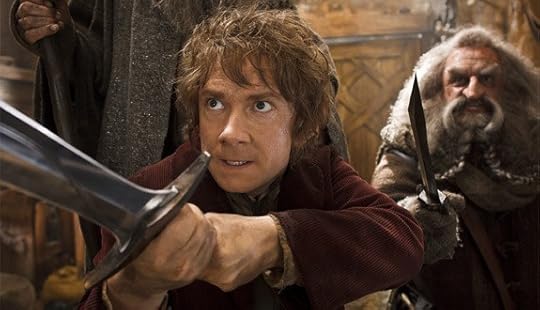A Small Thing, Packaged Big

Martin Freeman stars as Bilbo and John Callen as Oin in a scene from the movie "The Hobbit: The Desolation of Smaug." (CNS/courtesy of Warner Bros. Pictures)
A Small Thing, Packaged Big | Andrew Svenning | CWR
The Hobbit: The Desolation of Smaug suffers from poor pacing, too many special effects, and lack of focus.
When the rumblings began that The Hobbit, J.R.R. Tolkien’s prelude to his larger work, The Lord of The Rings, was coming to the big screen, I had reservations, but wasn’t put off entirely. After all, Peter Jackson was on board and I was generally impressed by his cinematic treatment of the trilogy, so optimism seemed warranted. Further credence seemed to come when it circulated that Guillermo Del Toro, a director with a clear eye for the mythological and fantastic who is noted for his love of practical, rather than computer-generated, effects, would collaborate with Jackson in realizing the more fairy-tale tone of the first foray into Middle Earth. But as MGM’s financial fiasco took its toll and stalled the project and Del Toro’s involvement evaporated—followed by the news that The Hobbit would be not one, but two films—worry crept in.
The Hobbit is, by all accounts, a smaller story than the epic Lord of the Rings. Jackson managed to make his Lord of the Rings a trilogy, with each book as one cinematic installment, at a time when the Weinstein brothers were interested in truncating the series into two movies. How was it, then, that one book of about 300 pages needed two movies, when a trilogy of more than 1,000 pages could manage in three? Then the news came out—not just two movies, but a new trilogy. The Hobbit was now a smaller thing, packaged big. It seemed that Tolkien was being treated to the new Hollywood truism of never telling a good—and financially lucrative—story too quickly.
I am not a purist; I am not opposed in principle to books being changed when adapted to the screen. Books are books and movies are movies. A little added here and a little removed there is going to be part of the polishing process as the story is imported from one medium to the other. But the new Hobbit film, The Desolation of Smaug, continues to demonstrate just how far south too much changing can go. When making any change in adapting a book to film, it should always be asked if the change harms the theme, intention, or characters of the original story. It also should be asked if the change helps the story work better within the limitations of a movie’s runtime.
The main problem with many of the changes and additions in The Desolation of Smaug is that they throw off the rhythm, allowing little or no time to develop either the invented plot elements or the original story. Am I opposed, in principle, to the addition of a burgeoning interracial romance between an invented elf warrior (Evangeline Lilly) and Kili the Dwarf? (If you were wondering why there was an oddly, ruggedly handsome man among the dwarves in the first film, this is the reason.) Perhaps not—if it is dramatically plausible and doesn’t stick out as contrived.
One of the big problems with the changes—some included to better connect with the LOTR films and some to stretch the Hobbit’s story to fill three films—is that they are creating waves of distortions in the overall storyline.
Carl E. Olson's Blog
- Carl E. Olson's profile
- 20 followers



